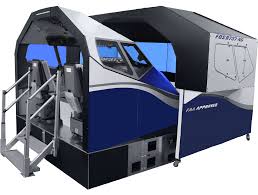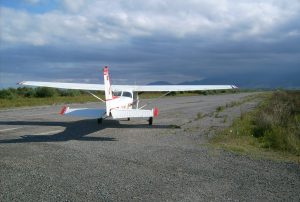Deep Dive Into A Flight Simulator
 In recent years, flight simulators have soared in popularity among aviation enthusiasts, gamers, and even professional pilots. These sophisticated systems offer an incredibly realistic experience of flying an aircraft, making them a popular choice for those looking to experience the thrill of aviation without leaving the ground. In this comprehensive guide, we’ll explore what makes a flight simulator stand out, the various types available, and why they are becoming increasingly significant in both recreational and professional contexts.
In recent years, flight simulators have soared in popularity among aviation enthusiasts, gamers, and even professional pilots. These sophisticated systems offer an incredibly realistic experience of flying an aircraft, making them a popular choice for those looking to experience the thrill of aviation without leaving the ground. In this comprehensive guide, we’ll explore what makes a flight simulator stand out, the various types available, and why they are becoming increasingly significant in both recreational and professional contexts.
What is a flight simulator?
At its core, a flight simulator is a software program or hardware system designed to replicate the experience of flying an aircraft. These simulators range from basic applications for casual users to complex systems used for professional training. They utilise detailed graphics, advanced physics engines, and real-world data to create a realistic flying experience.
Types of flight simulators
Flight simulators can be broadly categorised into several types based on their complexity and intended use:
- Consumer flight simulators: These are designed for enthusiasts and gamers who want an immersive flying experience from the comfort of their home. They often come with various aircraft models, detailed landscapes, and user-friendly interfaces. Examples include “Microsoft Flight Simulator” and “X-Plane.”
- Professional flight simulators: Used for pilot training and aviation research, these simulators offer high-fidelity simulations with a focus on realism. They include cockpit replicas, motion platforms, and real-world flight dynamics. Organisations like airlines and aviation schools frequently use these systems for training purposes.
- Educational flight simulators: These are aimed at students and educational institutions, offering a more accessible way to learn about aviation. They might be less detailed than professional simulators but still provide a good foundational experience.
Key features of top flight simulators
When selecting a flight simulator, certain features can significantly enhance the flying experience:
- Realistic graphics: High-resolution visuals and detailed scenery can make a huge difference. Top simulators use cutting-edge technology to render landscapes, weather conditions, and aircraft interiors with remarkable accuracy.
- Accurate flight physics: To simulate the feel of actual flight, the simulator must replicate aerodynamic principles and aircraft behaviour accurately. This includes factors such as weight, balance, and engine performance.
- Variety of aircraft: A good flight simulator should offer a range of aircraft, from small general aviation planes to large commercial airliners. This diversity allows users to explore different flying experiences and learn about various aircraft systems.
- Weather and environmental effects: Realistic weather conditions, including turbulence, wind, and precipitation, add to the immersion. Advanced simulators also incorporate dynamic weather systems that change over time.
- Customisability: Many users appreciate the ability to modify and enhance their simulator. This might include adding custom aircraft, creating new flight scenarios, or adjusting the simulation settings to suit personal preferences.
Benefits of using flight simulators
Flight simulators offer a wide range of benefits, from recreational enjoyment to practical applications:
- Educational value: For students and aspiring pilots, flight simulators provide an invaluable tool for learning the basics of aviation, understanding aircraft systems, and practicing flight procedures. They offer a safe environment to experiment with different scenarios and gain hands-on experience.
- Training efficiency: For professional pilots, simulators are essential for honing skills and practicing emergency procedures. They allow pilots to simulate a wide range of scenarios, including rare or challenging conditions, without the risks associated with real-world flying.
- Entertainment: For enthusiasts and gamers, flight simulators offer an engaging and immersive experience. They can explore the world from above, participate in virtual airshows, and enjoy the thrill of piloting various aircraft.
- Accessibility: With advancements in technology, flight simulators have become more accessible to a broader audience. High-quality simulators are now available for home use, providing an affordable way to experience aviation.
Future of flight simulators
The flight simulation industry is constantly evolving, driven by technological advancements and user demands. Here are some trends and innovations shaping the future of flight simulators:
- Virtual Reality (VR) integration: VR technology enhances immersion by providing a 360-degree view of the virtual cockpit and surroundings. This advancement allows users to feel more connected to the simulation and experience a more lifelike flying environment.
- Artificial Intelligence (AI): AI is being used to create more dynamic and responsive environments. For example, AI can be employed to simulate air traffic, generate realistic weather patterns, and adapt to user behavior in real time.
- Cloud-based simulations: Cloud computing offers the potential for more powerful simulations with improved graphics and processing capabilities. Cloud-based platforms also enable seamless updates and expansion of the simulation environment.
- Community and modding: The flight simulation community is highly active, with users creating and sharing custom content. This includes new aircraft models, scenery packs, and mission scenarios, which enrich the overall simulation experience.
Popular flight simulators to explore
If you’re considering diving into the world of flight simulators, here are some popular options to explore:
- Microsoft flight simulator: Known for its stunning graphics and detailed world, Microsoft Flight Simulator is a leading choice for both enthusiasts and professionals. Its comprehensive global map and realistic weather systems set it apart from other simulators.
- X-Plane: X-Plane offers a high level of realism with its advanced flight physics and wide range of aircraft. It is also highly customisable, allowing users to modify and enhance their simulation experience.
- FlightGear: As an open-source simulator, FlightGear provides a cost-effective option for those interested in aviation. It features a range of aircraft and environments and benefits from community-driven updates and improvements.
- Aerofly FS: Aerofly FS is known for its user-friendly interface and solid performance. It strikes a balance between realism and accessibility, making it a good choice for both beginners and experienced users.
Synthetic flying
Flight simulators offer a remarkable way to experience aviation, whether you are a casual gamer, a budding pilot, or a seasoned professional. With their ability to replicate the experience of flying an aircraft, these simulators provide valuable educational tools, engaging entertainment, and practical training solutions. As technology continues to advance, flight simulators will likely become even more realistic and accessible, opening new horizons for aviation enthusiasts around the world.
Whether you are interested in the latest cutting-edge simulators or simply looking for a way to enjoy the thrill of flying, there’s a flight simulator out there that can meet your needs. Dive in and explore the fascinating world of aviation simulation—your next adventure awaits in the virtual skies.










